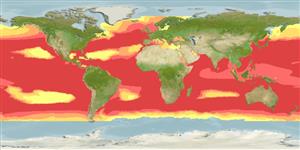Elasmobranchi (squali e razze) (sharks and rays) >
Carcharhiniformes (Ground sharks) >
Carcharhinidae (Requiem sharks)
Etymology: Prionace: prion (Gr.), saw; akis (Gr.), point or barb, referring to serrated (saw-like) cusps on teeth of upper jaw. (See ETYFish); glauca: Latin for bluish green or gray (i.e., sea-colored), referring to its color (blue above, whitish below). (See ETYFish).
More on author: Linnaeus.
Environment: milieu / climate zone / depth range / distribution range
Ecologia
marino; salmastro; oceanodromo (Ref. 51243); distribuzione batimetrica 0 - 1082 m (Ref. 89422), usually 1 - 220 m (Ref. 55193). Subtropical; 7°C - 21°C (Ref. 244); 70°N - 55°S, 180°W - 180°E
Circumglobal in temperate and tropical waters. Western Atlantic: Newfoundland, Canada to Argentina. Central Atlantic. Eastern Atlantic: Norway to South Africa, including the Mediterranean. Indo-West Pacific: East Africa to Indonesia, Japan, Australia, New Caledonia, and New Zealand. Eastern Pacific: Gulf of Alaska to Chile. Probably the widest ranging chondrichthyian. Highly migratory species.
Length at first maturity / Size / Peso / Age
Maturity: Lm 199.1, range 170 - 221 cm
Max length : 400 cm TL maschio/sesso non determinato; (Ref. 35388); common length : 335 cm TL maschio/sesso non determinato; (Ref. 5217); peso massimo pubblicato: 205.9 kg (Ref. 40637); Età massima riportata: 20 anni (Ref. 27347)
Spine dorsali (totale): 0; Raggi dorsali molli (totale): 0; Spine anali 0; Raggi anali molli: 0. A slim, graceful blue shark with a long, conical snout, large eyes, and curved triangular upper teeth with saw edges; pectorals long and narrow; no interdorsal ridge (Ref. 5578). Dark blue dorsally, bright blue on the sides, white ventrally (Ref. 5578). Tips of pectoral fins and anal fin dusky (Ref. 9997). The first case of diprosopus tetrophthalmus (cranofacial duplication) in a foetus of this species was reported from South Atlantic (Ref. 119190).
Oceanic, but may be found close inshore where the continental shelf is narrow (Ref. 6871, 58302). Usually found to at least 150 m (Ref. 26938). Maximum size from Ref. 128029. Reported from estuaries (Ref. 26340). Epipelagic, occasionally occurs in littoral areas (Ref. 58302). Feeds on fishes (herring, silver hake, white hake, red hake, cod, haddock, pollock, mackerel, butterfish, sea raven and flounders (Ref. 5951)), small sharks, squids, pelagic red crabs, cetacean carrion, occasional sea birds and garbage (Ref. 5578). Viviparous (Ref. 50449). Sexual dimorphism occurs in skin thickness of maturing and adult females (Ref. 49562). May travel considerable distances (one specimen tagged in New Zealand was recaptured 1,200 km off the coast of Chile) (Ref. 26346). Potentially dangerous to humans (Ref. 6871, 13513). Marketed fresh, dried or salted, and frozen; meat utilized for consumption, hides for leather and fins for soup (Ref. 9987). Sexually mature at 250 cm long and 4-5 years old. The female gives birth up to 80 young measuring 40 cm long, gestation lasts almost a year (Ref. 35388). Produces from 4 to 135 young a litter (Ref. 26938). Minimum depth from Ref. 125614.
Distinct pairing with embrace (Ref. 205). Viviparous (Ref. 26281), placental (Ref. 50449); 4-63 young in a litter (Ref. 9997); 4-135 (usually 15-30) pups (Ref.58048), about 35-44 cm at birth. Gestation period ranges from 9 to 12 months (Ref. 244).
Sexual dimorphism is evident in skin thickness of maturing and adult females (Ref. 49562). Females have thicker skin layer than males of the same size (Ref. 49562).
Compagno, L.J.V., 1984. FAO Species Catalogue. Vol. 4. Sharks of the world. An annotated and illustrated catalogue of shark species known to date. Part 2 - Carcharhiniformes. FAO Fish. Synop. 125(4/2):251-655. Rome: FAO. (Ref. 244)
IUCN Red List Status (Ref. 130435)
Threat to humans
Traumatogenic (Ref. 4690)
Human uses
Pesca: scarso interesse commerciale; Pesce da pesca sportiva: si
Strumenti
Special reports
Download XML
Fonti Internet
Estimates based on models
Preferred temperature (Ref.
123201): 5.9 - 25.2, mean 14.8 °C (based on 1945 cells).
Phylogenetic diversity index (Ref.
82804): PD
50 = 1.0000 [Uniqueness, from 0.5 = low to 2.0 = high].
Bayesian length-weight: a=0.00447 (0.00371 - 0.00538), b=3.10 (3.05 - 3.15), in cm total length, based on LWR estimates for this species (Ref.
93245).
Trophic level (Ref.
69278): 4.4 ±0.2 se; based on diet studies.
Generation time: 8.0 (6.9 - 9.9) years. Estimated as median ln(3)/K based on 23
growth studies.
Resilienza (Ref.
120179): Basso, tempo minimo di raddoppiamento della popolazione 4.5 - 14 anni (rm=0.031; K=0.16; tm=6; tmax=20; Fec=4-135).
Prior r = 0.06, 95% CL = 0.04 - 0.10, Based on 6 stock assessments.
Fishing Vulnerability (Ref.
59153): High to very high vulnerability (67 of 100).
Climate Vulnerability (Ref.
125649): High vulnerability (57 of 100).
Nutrients (Ref.
124155): Calcium = 7.26 [1.20, 39.50] mg/100g; Iron = 0.69 [0.17, 2.12] mg/100g; Protein = 22.1 [19.8, 24.2] %; Omega3 = 0.337 [0.134, 0.841] g/100g; Selenium = 15.4 [5.5, 45.8] μg/100g; VitaminA = 6.1 [1.9, 18.9] μg/100g; Zinc = 0.232 [0.129, 0.610] mg/100g (wet weight); based on
nutrient studies.
